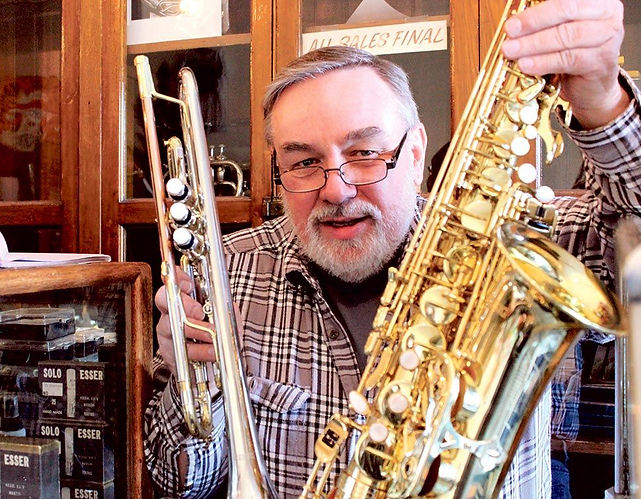The tale of a legendary Montery mounthpice-maker.
Latest News | January 2, 2016
Source: montereycountyweekly
Tucked away in a cozy spot on Polk Street in Monterey lies a treasure trove of musical history. Just steps away from the end of Alvarado Street, the shop’s brightly lit front windows reveal a variety of instruments: saxophones, clarinets, trumpets, trombones.
Most Shared
Featured
Music
Upcoming Music Festivals

There’s also a plethora of musical memorabilia in the window, including a letter on White House stationery from then-president (and saxophonist) Bill Clinton, grateful for sax mouthpieces, plus numerous endorsement letters from students and customers.
It becomes apparent in talking with owner Kurt Heisig that this is no ordinary music store, nor is Heisig an ordinary teacher or performer.
He speaks with a clear passion for what he does. He teaches and/or plays a vast array of wind and brass instruments: all of the saxes, from soprano to bass; all of the clarinets, including the bass; the flute family; the double-reeded oboe family, along with the bassoon; the recorder, a medieval instrument; and nearly all of the brasses – trumpet, flugelhorn, cornet, pocket trumpet, French horn, euphonium, a variety of trombones, and even the tuba.
He believes being able to master and ultimately teach such a large number of instruments isn’t as difficult as it seems, with a big caveat.
“They are all very hard, unless you have three things – a good horn, a good mouthpiece, and a great teacher,” he says. “Along the way, I was fortunate to have had all three of those, over and over again, which made it easy for me. But if even one of those three is sub-par, learning to play can be very difficult, causing many students to give up out of frustration.”
A huge group of musicians sing Heisig’s praises, including jazz soloist Grover Washington Jr. (“… he’ll teach you right… ”); saxophonist Odean Pope, who played with Max Roach and was a protégé of John Coltrane (“A premier saxophonist and the greatest saxophone teacher in the world”). And Philadelphia freelance trumpeter Matt Sweeney said, “Any trumpeter who is not satisfied with his horn’s tone, playability, or his teacher, go and see Kurt, and follow everything he says to the letter.”
Heisig began to dabble in instrument repair as a student at San Jose State in the ’60s, for a utilitarian reason: He would fix flaws he found while playing. A few years later, a long-time association with his first main influence, Ralph Morgan, former chief woodwind designer for Selmer USA, the largest producer of wind instruments in the world, led Heisig to manufacture his own eponymous brand.
At age 20 there came a moment he believes was divine intervention.
“I suddenly knew I was a saxophone mouthpiece maker, and I was also shown just how to do it. I actually felt each of my fingers move around a mouthpiece showing me what to do.”
It was this revelation, plus the ensuing four decades of practice, that launched him into a new phase of his career for which he has ultimately become famous among brass and wind players worldwide. Those same musicians now regard him as a master mouthpiece maker. Minute changes to a mouthpiece, made using tiny tools, can cause dramatic changes in an instrument’s tone quality, ranging from darker tones to wilder, brighter ones.
“I can count the number of us who still do this on the fingers of one hand,” Heisig says. “It’s a dying art.”
In 1981, he opened a store in Saratoga, operating it for 29 years. Heisig moved into his current location in 2011. Now in the fifth decade of his career, nearly all of his new students have become customers (or vice versa). Over those decades, the list of those he has worked with has spanned the genres of rock, jazz and classical. It includes brass and wind players from Los Lobos (Steve Berlin), Sheila E & Pete Escovedo’s Jazz Band (Manny Angel), Tower of Power saxman Tom Politzer, jazz players Pharoah Sanders, Eddie Harris and Grover Washington Jr., and the principal clarinetists of the San Francisco, Boston and Portland symphony orchestras, to barely scratch the surface.
In addition to spending nearly 30 years of teaching and manufacturing instruments, Heidig has played in numerous classical and ragtime saxophone quartets throughout the Bay Area. He now divides his spare time by playing in both the Monterey Peninsula College jazz and symphonic bands.
“By improving the quality of the instruments, mouthpieces and musical instruction, my goal is to help make Monterey the symphonic band capital of the world,” Heisig says.
He would be one of the atypical types well qualified for the effort.






















